
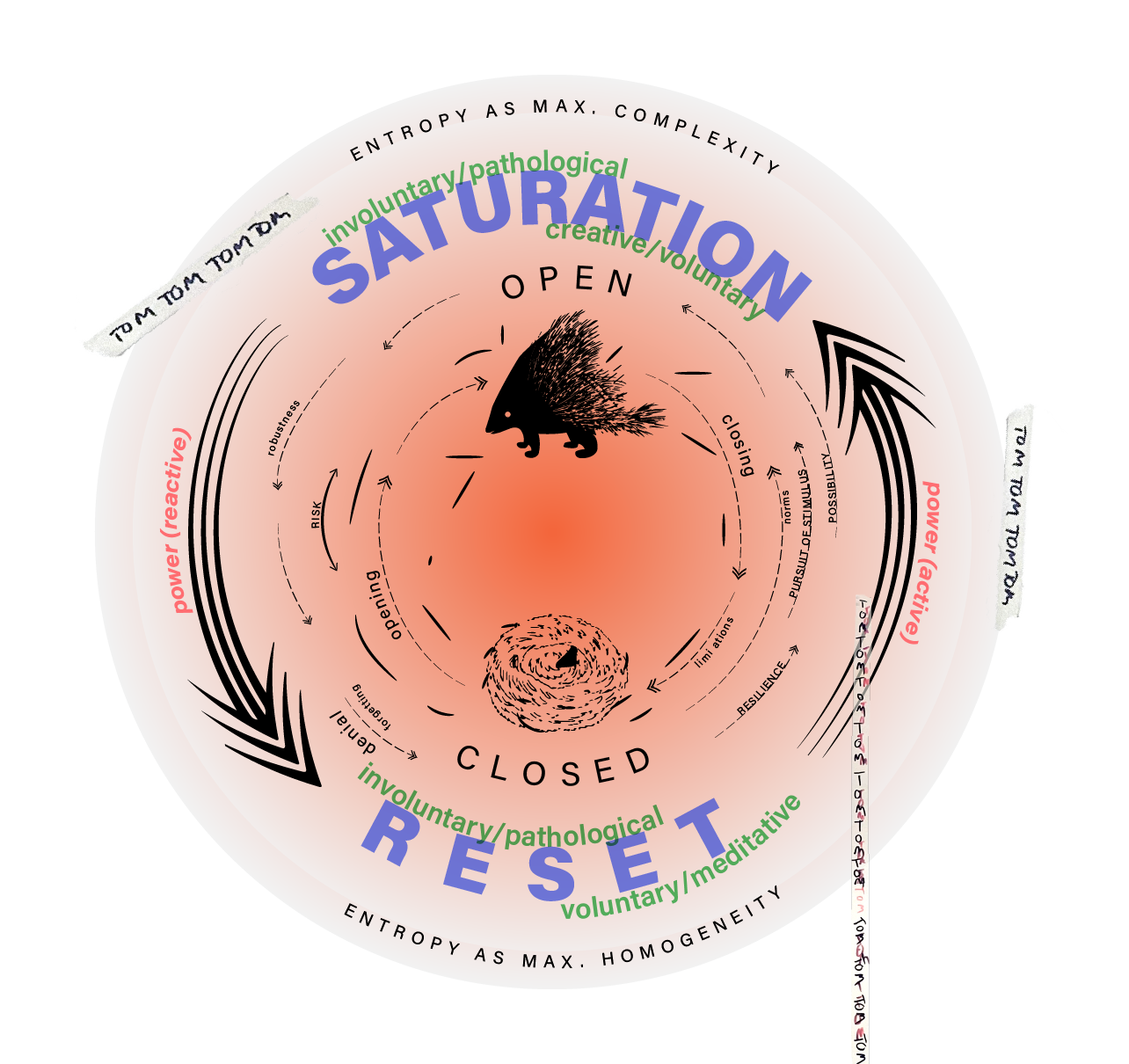
Living individuals, collectives and ecosystems are characterised by processes of self-regulation in view of maintaining homeostasis in the face of fluctuations and change in the environment. This essentially conservative function of self-preservation has been foregrounded in cybernetics and linked with the idea of information as negation of entropy and robustness to noise, in other words: of unforeseen variation or of energy not available for work. The ‘porcupine diagram’ looks at the relation between self-regulation and change, whether confronting the individual, collective or ecosystem, or brought about by it. Here the tension is between, on the one hand, self-regulating mechanisms, aimed at maintaining a physiological, psycho-social or ecosystemic equilibrium, and the requirement of openness towards variation and change, ensuring what Ross Ashby called the “requisite variety” of possible responses to unforeseen changes. Fundamental to it is the idea, developed by Henri Altan, of complexity on the basis of noise, which we will here interpret as a factor of resilience based on its relative incorporation: noise in terms of the potential for greater variety of possible responses to unforeseen changes or events. Atlan’s concept of “complexity on the basis of noise” was criticized by people like René Thom and more recently Rainer Zimmermann, and there is some dispute over its value within the NRU group. However in this context it retains a heuristic value with regards to singular and collective dynamics navigating the tension between closure and openness, self-preservation and risk, if not: conservative and revolutionary impulses. The circularity of the diagram, showing the porcupine opening and closing, does not aim to suggest a cyclicality that would annul history, as a rigid dialectical pendulum between revolution and counter-revolution, nor does it mean to imply a causal progression from openness to closure to openness, and so forth, indefinitely. If it is a pendulum, it is more like a double pendu- lum whose trajectory is unpredictable. Rather, the progression towards greater openness may simultaneously increase the pressure towards closure, understood here as an increased requirement for predictability and sameness, while the increasing closure or rigidity may increase the pressure towards openness. At stake here is the importance of understanding the dynamical progression between these conflicting needs as something that cannot be resolved once and for all, but that may be navigated in different ways. This is indicated by the bifurcation between closure as either a relatively compulsive catastrophic reaction, leading to an amplification of crisis, or as deliberate self-regulation and management of complexity, in the way for instance of ‘ritual’ practices. Closure and openness at their extreme constitute a kind of ouroboros, symbolised by the snake biting its tail. The pressure towards greater openness, likewise, may bifurcate or fluctuate between abrupt and uncontrolled change, fuelling chaos and with it the greater likelihood of a catastrophic reaction, or as a deliberate process with controlled variables, as for instance in artistic experimentation. In terms of the theory of knowledge one may usefully apply this diagram as representing the conflicting pressures of what Thomas Kuhn called normal science, aimed at the consolidation and axiomatic saturation of a given paradigm, and on the other hand, the scientific challenging of paradigms, which may invalidate a theory or lead to paradigm shifts. Taking a more speculative wide angle on anthropology, Gilles Deleuze and Félix Guattari’s notions of territorialisation and deterritorialisation may fruitfully be thought within the dynamic of this diagram. Deleuze’s conception of difference and repetition, may further open another perspective on colosure, if interpreted as repetition, as bearing difference within it, while openness, if associated with difference, could also be thought as entailing the repetition of difference. On the other hand events requiring a novel response, associated with increased risk which, however, is still in the service of self-preservation—insofar as it satisfies the principle of “requisite variety” (Ashby) of possible responses is an insurance policy against an unpredictably changing environment. The homeostatic function permeates the entire system, from its time tested and most inflexible strata to the most flexible. Conversely the propensity for variation may permeate “downwards,” to varying degrees, affecting not only the most recent and most flexible strata of acquired responses, but potentially also more ancient and less flexible strata (Yağmur Denizhan). The porcupine is a humorous metaphor for the relevance of this apparent conflict of interest (resisting variation, seeking variation) for different scales of self-organisation. The hypothesis is that a rigid set of responses, when inadequate to changing circumstances, eventually provokes an impulse towards variation. The circularity in the diagram seeks to indicate that as the variation of possible responses increases, so does the risk of a reaction to perceived risk, in the form of a sudden reversal to rigidity and relative closure of a more narrow set of possible responses. At stake is the tension between the stabilizing power of established norms, and the creativity and risk involved in normativity as the power to revise existing norms and institute new ones. The question this diagram raises is: to what extent do circular dynamics of closure calling for variation and variation provoking closure—apply to the individual, the collective, and at which levels (physiological, psychological, sociopolitical, etc.)?
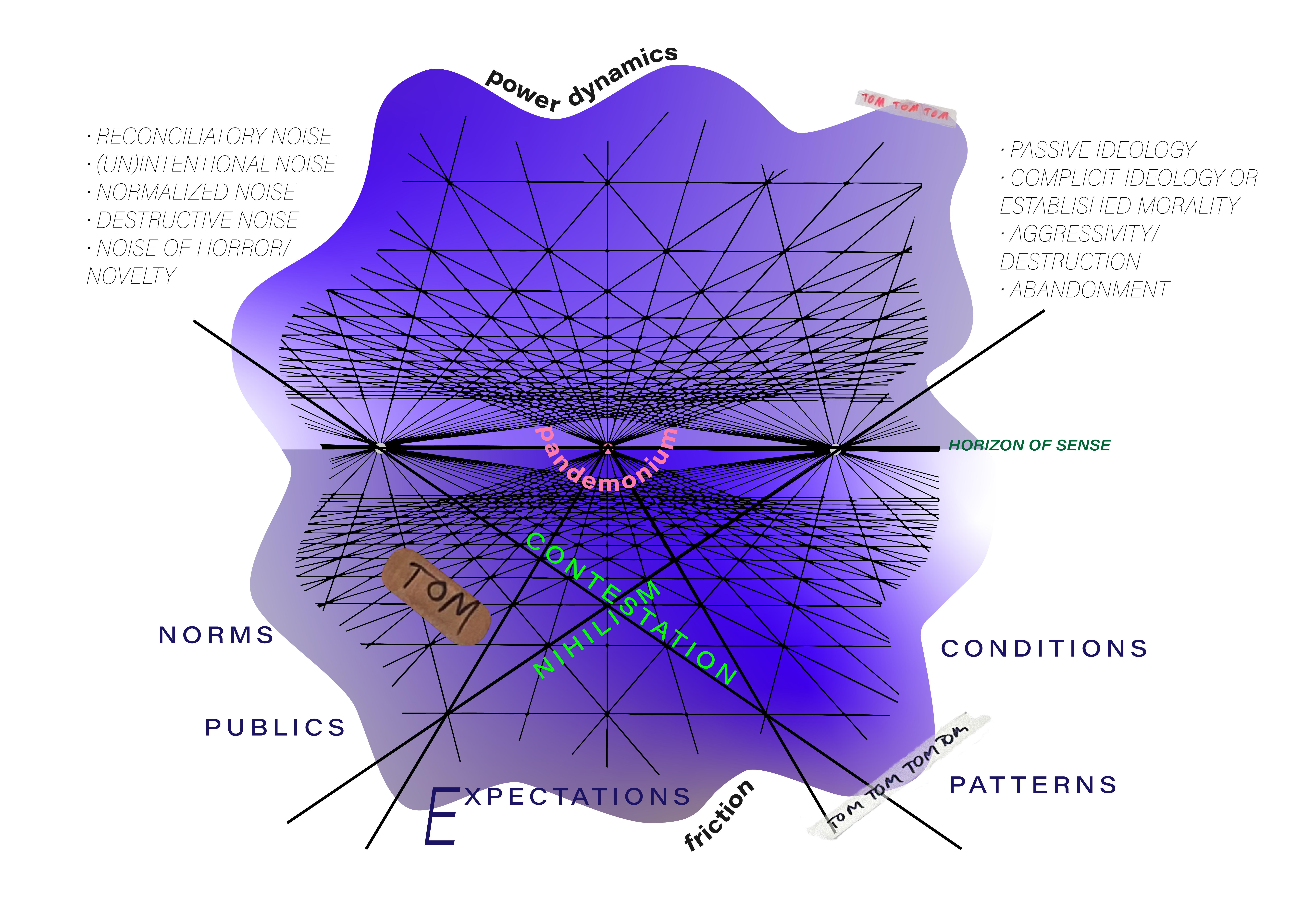
In this diagram, noise is seen through the lens of the established association of noise with disruption and contestation. This diagram reinterprets noise in a set of relationships that ensue from the frictions created by power dynamics. Noise-as-nihilism and noise-as-contestation are considered in their different degrees of possible intensity, and in this diagram can be understood as phases or types:
1) Noise of horror/novelty: affords the idea of dynamics between these polarities;
2) Destructive noise: as the possibility/promise of pandemonium (“Dyonisiac noise”);
3) Normalized noise: could leading to a type of nihilism/cynicism or reconciliation;
4) (Un)intentional noise: symptomatology of norms (e.g., farting).1) Aggressivity/destruction: destructive noise, convergence towards pandemonium/ threshold of sense;
2) Complicity w/ ideology/established morality: e.g., normalized noise as acceptance;
3) Passive (hippie) ideology: e.g., normalized noise as disengagement;
4) Abandonment: lack of awareness and/or bordering on the threshold of sense.
Contestation and nihilism radiate towards and beyond the horizon of sense. This transcendence marks the collapse of the diagram, and the undoing/unsensing of the possibility of the very frictions that created the premises for contestation and nihilism in the first place. This is where pandemonium ensues. Evrim Bayındır, one of the authors of the diagram, says:
“‘Pandemonium’ is from Nietzsche’s ‘How the True World Finally Became a Fable’ in Twilight of the Idols where he speaks of the ‘pandemonium of all free spirits’, some sort of a celebration of the collapse of metaphysical dualities that have dominated the history of philosophy so far. It is only one page and written in fable form. The easiest way to think of pandemonium is perhaps to perceive it as a multiplicity that cannot be subsumed in unity since such a subsumption is the kind of metaphysical dualism that Nietzsche was criticizing in the fable. Pandemonium should also be understood as some kind of a social multiplicity, as it brings a community of free spirits. Nietzsche believes that metaphysics cannot be overcome without a social upheaval. But why does he use a sonic term to explain multiplicity? We know Nietzsche was a composer and wrote a lot about music, there must be a connection that is worth following. The German word he uses is Teufelslärm and the dictionary translates it as “hell sound,” which sounds even more interesting. Perhaps pandemonium as a sonic and social multiplicity is not a mere limit experience as in the general understanding of noise as chaos, but something that is produced after the end of metaphysical dualities such as models-copies, necessity-chance, unity-multiplicity, real world-apparent world, etc.”
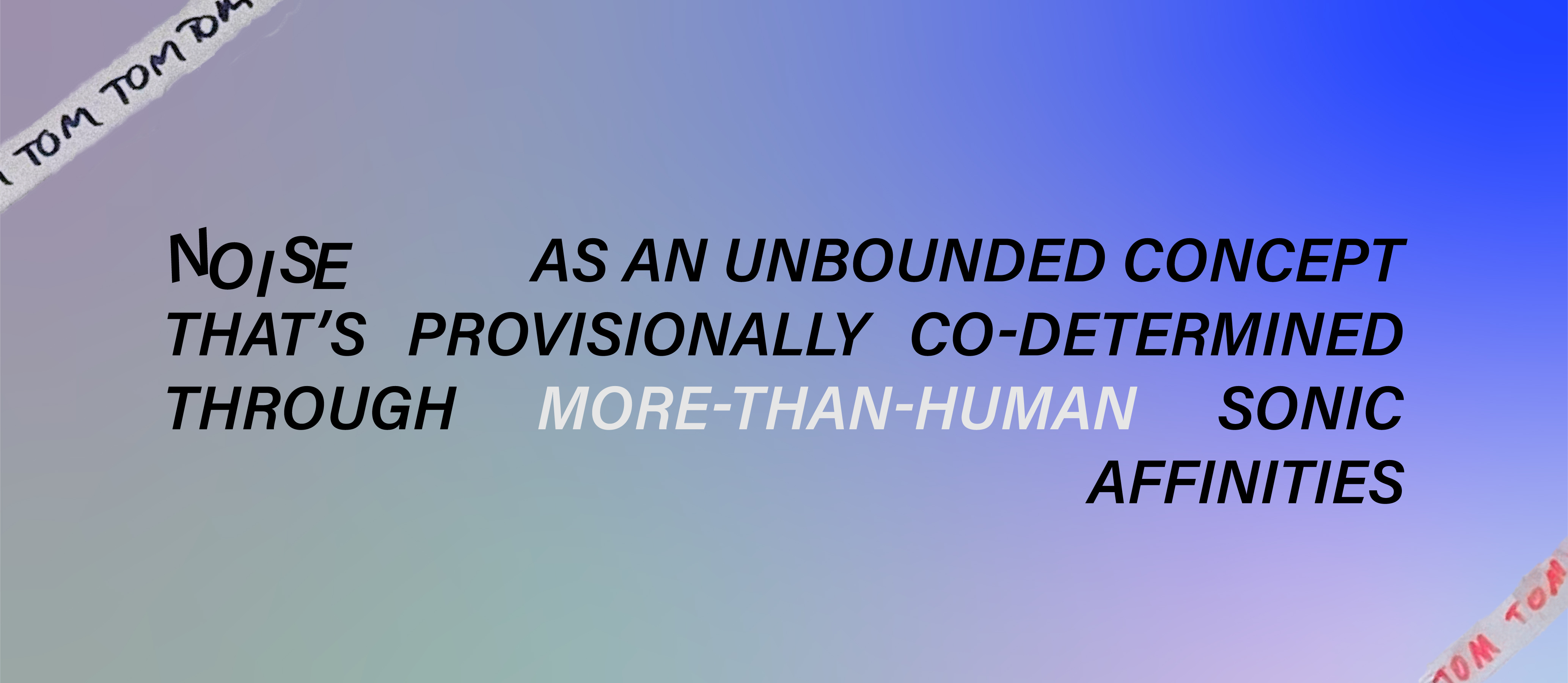
This diagram was prompted by the subject of ecology, and has no description because it is meant as a score.
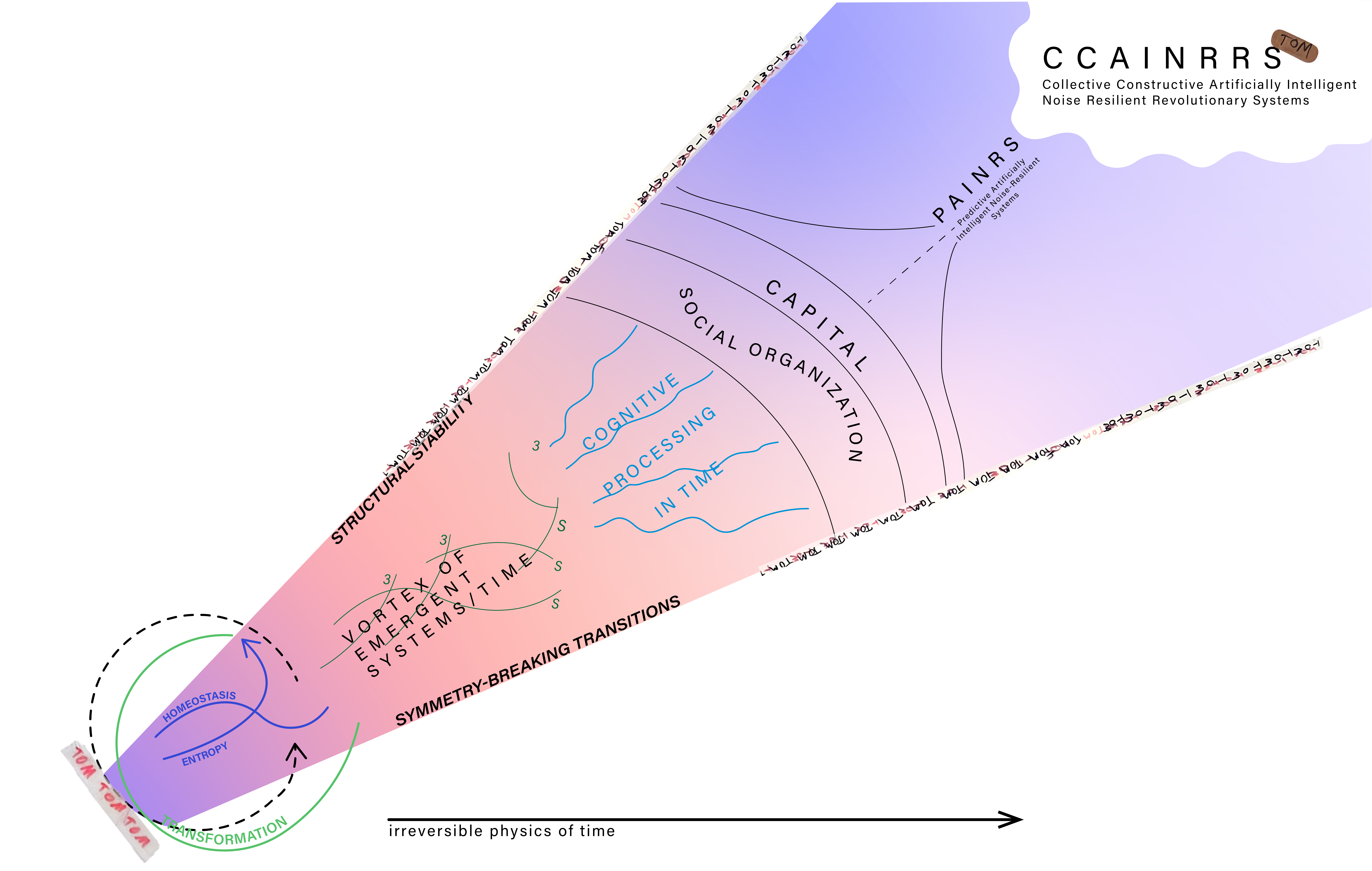
This diagram links the dynamics of time, understood in terms of processes and processing, to the contemporary political situation. We first understand the irreversible physics of time, described by thermodynamics, complexity theory, and more recently assembly theory, as a background condition for the understanding of dynamic processes, which constitute time through the historicity of their dynamics. Emergent systems resist entropy over some finite time, not only through homeostatic self-maintenance but through radical transformation of the system itself, the environment, and the system-environment interaction. The latter can be represented as symmetry breaking transitions that alter the phase space of the modeled dynamics. The chaotic non-linear dynamics of interacting emergent systems creates a turbulent vortex of time(s). The emergence of cognitive systems similarly leads to diverse forms of experienced temporalities, relative to the material conditions of cognitive processing and agent-environment interactions. We understand all cognitive systems as predictive systems, which act not only in relation to the linear and contingent unfolding of past causes and effects (reactive awareness), but also by acting on the future, and sculpting its possibilities. Human social systems have, of course, massively transformed not only the environment, and the ways in which we interact with it, but also what it means to be human. This process suddenly accelerated about four hundred years ago with the emergence of capitalism, entering into a series of transitions by regenerative feedback processes that further accelerated the cascade of symmetry breaking events, more recently spurred by the development of computing (early 20th century) and internet technologies (late twentieth century). At the previous NRU workshop in Porto (2021) we had conceived of the difference between noise in the 20th century and in the contemporary condition. This difference would be in terms of a shift in the image of thought and in the form of power, from a system based on robustness to noise and the statistical governance of a biopolitical mass through the maintenance of relatively fixed order parameters, to a system based on resilience to noise and the constant modulation of dividuals (Deleuze) through big data analysis, massive surveillance, and predictive AI modeling. We called these Predictive Artificially Intelligent Noise Resilient Systems (PAINRS). The ‘vortex of emergent times’ is currently being managed by a number of big organisations, states and corporations whose interests are either geopolitical dominance or profit maximization. For most humans, and other animals, the current production of times leads only to further immiseration and extinction. We wondered if there could be any other future than this expanding destructive rampage, this pervasive capture and extraction of all nature in the drive for profit or domination. If profit has captured the future too, (how) can it be stolen back? We thought the only possible way out of the current form of power, other than extinction, is the reappropriation of predictive AI technologies, so that they may be directed under common ownership towards revolutionary ends and the construction of new possibilities. We called these Collective Constructive Artificially Intelligent Noise Resilient Revolutionary Systems (CCAINRRS).
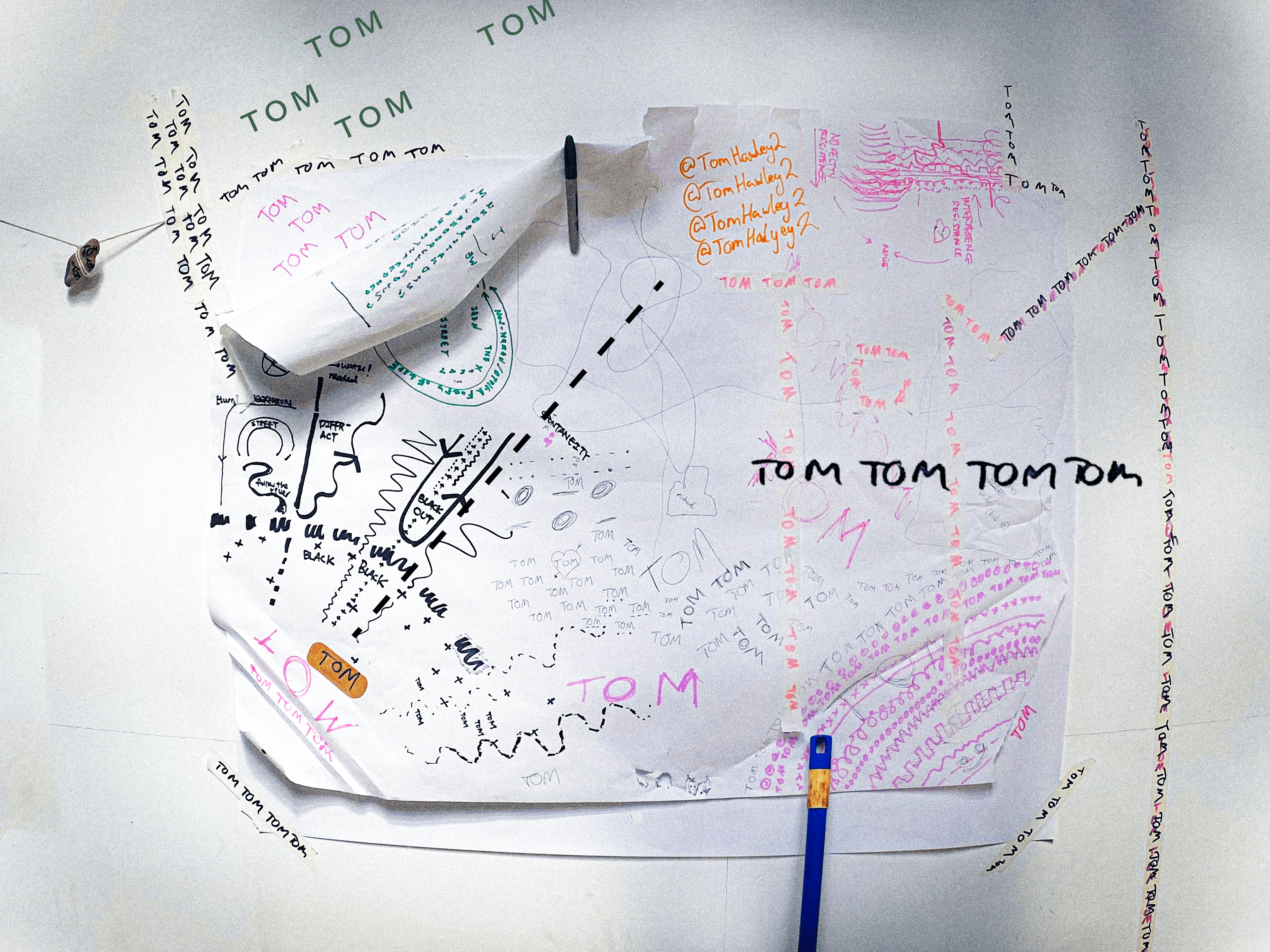
This diagram expresses the contradiction of diagramming noise: it is not only the very concept, but also the process of diagramming which is dynamic, unstable, and undetermined, while the outcomes (the “final” diagrams) are fixed and static. The desire for the collective process of diagramming noise to be amenable to the practices/concepts the diagrams intend to describe, is not amenable to the result they propose. Our starting point for the creation of this diagram was five people and a sheet of paper; each took a corner (two people took one corner together), thereby acknowledging the set constraints of the four corners of a square sheet of paper. Each corner started tracing and unraveling what they perceived was being communicated by the other corners. In doing so, some expressed synesthetic interpretations, translating ‘oscillations’ and ‘vibes’ into lines and scribbles. Others attempted to diagram the power dynamics that emerged from the fact that while some talked and explained, others listened, while some understood, others were left wondering, etc. Another corner took an alternative (metamodern) route to the supposed self-professed “transparency” of the exercise as it unfolded, taking the joke to a meta-level. This duo began an experiment in the abuse and encryption of noise. “TOM” became a running gag that most of the group had no access to, while at the same time: there was nothing to be “gotten”; “TOM” was also a very clear and simple message/word/term/recognizable name/etc. Making their gesture both banal and cryptic. And funny. The repetition of this sign or symbol, which took over the diagram and went beyond the scope of paper’s surface, became a sort of noise, but also the most exemplary element of the phenomenon we were gravitating around: the very contradiction of diagramming noise. Other elements unfolded (pun intended) as we played with the materiality of the paper and structured it into three-dimensional shapes, beyond its tacit two-dimensionality. During the presentation of the diagram, we also played with the fact that TOM went beyond the presentation and took on a performative role, transgressing the form of the presentation. This meta-critique of the diagramming methodology retroactively affected/infested the previous diagrams, which is why you saw traces of TOM appearing in the previous diagrams.
These diagrams are the result of a workshop facilitated by NRU at Cafe OTO, London (UK), on 18 May 2022, during the three-day residency of NRU member Mattin.
Thanks to the participants:
Giulia Astesani Seth Ayyaz Halit Evrim Bayındır Adam Denton Steve Goodman Tim Goldie Rachel Gordon Fielding Hope Anneke Kampman Li Hang Liu Weitian Eugenio Luciano Luciano Maggiore Roberto Garcia Mallo Nikolaos Sakkadakis Joseph Sergi Lisa Skuret Rosy Spencer Kevin Logan Carol Mancke Laila Sakini
*Due to the fact that some participants joined without signing up, there might be names missing from this list. Please get in touch if you wish to be credited, or for your name be removed: noiseresearchunion at protonmail.comThe NRU diagrams are always collaborative creations of the workshop participants + NRU, and translated digitally by NRU + Diede van Ommen. Since its inception, NRU has been funded and supported by the NRU members, and depending on the event, also by: SOOPA, v2_ Rotterdam, Collège International de Philosophie, Bidston Observatory, Café OTO, Stimuleringsfonds, UNSOUND Festival, and more.
For any questions please contact us at: noiseresearchunion at protonmail dot com